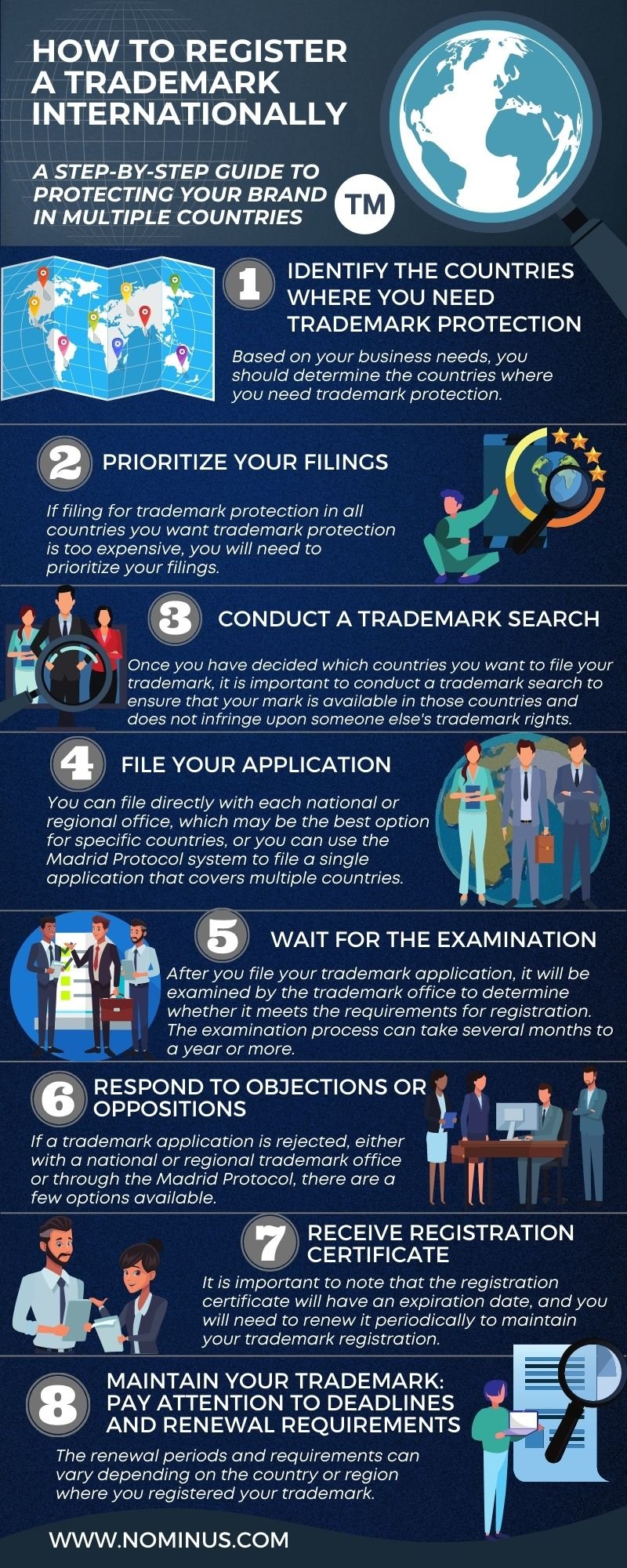How to Register a Trademark Internationally: A Step-by-Step Guide
Table of Content
1. Identify the countries where you need trademark protection
2. Prioritize your filings
3. Conduct a trademark search
4. File your application
5. Wait for the examination
6. Respond to objections or oppositions
7. Receive registration certificate
8. Maintain your trademark: Pay attention to deadlines and renewal requirements
Final Thoughts
Trademark registration is a crucial step for any business looking to protect its intellectual property and brand identity, especially for those planning to expand internationally. While filing for trademark protection can be a complex and time-consuming process, it is well worth the effort to ensure that your brand is protected in the countries where it matters most to your business.
In this article, we will provide a step-by-step guide to registering a trademark internationally, including conducting a trademark search, identifying the countries where you need trademark protection, prioritizing your filings, filing your trademark application, responding to objections or oppositions, receiving your registration certificate, and maintaining your trademark registration. By following these steps, you can ensure that your trademark is protected, and that your business is set up for success in the global marketplace.

1. Identify the countries where you need trademark protection
Based on your business needs, you should determine the countries where you need trademark protection. It is important to evaluate where your products or services are currently being sold, as well as where you plan to expand in the future.
Additionally, it is important to consider countries where your competitors are currently or plan to do business, as well as countries where counterfeiting and intellectual property theft are high. By taking these factors into account, you can ensure that your trademark is protected in the countries where it matters most to your business.
2. Prioritize your filings
If filing for trademark protection in all countries you want trademark protection is too expensive, you will need to prioritize your filings. It would be best if you considered the significance of your business in each country, as well as the expenses associated with filing in that country. Additionally, the filing system of the country should be considered; some countries have a "first to file" system, which means that the first person to file for a trademark owns it, while others have a "first to use" system, which means that the person who first uses the trademark in commerce has ownership rights.
Defensive filing is also necessary for countries where trademark squatting is prevalent, as it can prevent others from registering and using your mark. By prioritizing your filings, you can ensure that you are protecting your trademark where it matters most to your business while managing the associated costs.
3. Conduct a trademark search
Once you have decided which countries you want to file your trademark, it is important to conduct a trademark search to ensure that your mark is available in those countries and does not infringe upon someone else's trademark rights.
You can conduct a trademark search on your own with a free tool or hire a trademark attorney to do it for you. While a free tool can provide a general idea, it is highly recommended that you request a comprehensive trademark study from a trademark attorney for each country where you want to file a trademark. This study includes a review of specialized databases, a class study based on your products or services, a graphic and phonetic trademark search, and an analysis of the likelihood of registration.
Attorneys can examine existing trademarks to ensure that your desired mark is unique and not already used by another party. This is important because if you attempt to register a mark already in use, it could result in legal issues such as infringement lawsuits or rejection of your application.
What happens if the trademark is already being used?
-
if the trademark you want to register in a specific country is already being used by someone else, you may need to consider choosing a different trademark or modifying your trademark to make it more distinct. In some cases, it may be possible to negotiate a coexistence agreement with the existing trademark holder, allowing both parties to use the same or similar trademarks in the same market without infringing on each other's rights. However, this option can be complicated and may require the assistance of a trademark attorney.
-
In some cases, you may be able to request the cancellation or annulment of a trademark that is registered and being used by another party. The specific procedures and requirements for cancellation or annulment of a trademark can vary by country, but generally, you may be able to file a petition or opposition with the relevant trademark office or court to challenge the validity of the registered mark.
For example, you may be able to challenge a trademark registration on the grounds that it was obtained fraudulently, that the mark has become generic or descriptive, or that the owner has not used the mark for a certain time. However, cancellation or annulment proceedings can be complex and time-consuming, and the outcome can depend on the specific facts and circumstances of your case. It is recommended that you consult with a trademark attorney familiar with the laws and procedures in the relevant jurisdiction to determine the best course of action.

4. File your application
Once you have determined the countries where you need trademark protection (1), prioritized your filings (2), and conducted a trademark search (3), you can file your trademark application with the appropriate national or regional trademark office.
You can file directly with each national or regional office, which may be the best option for specific countries, or you can use the Madrid Protocol system to file a single application that covers multiple countries.
Filling directly with the national or regional trademark registry:
Advantages:
-
Allows for greater flexibility in the application process, as national laws and procedures can be considered.
-
Generally, less expensive than the Madrid Protocol system for filing in a single or few countries.
Disadvantages:
-
Multiple filings are required for each country, which can be time-consuming and expensive.
-
May require working with multiple trademark agents or attorneys in different countries.
-
Lack of uniformity between national trademark laws and procedures can lead to more complexity and potential for errors.
Filling using the Madrid Protocol:
-
Allows for filing in multiple countries with a single application, saving time and reducing costs.
-
Simplifies the application process by providing a standardized application form and procedure.
Disadvantages:
-
Countries can choose to refuse protection for a trademark, even if it is approved by the International Bureau, which can result in additional costs and complexity.
-
The initial cost of filing can be higher than filing directly with a national trademark office.
-
The Madrid Protocol system may not be available in all countries, and certain countries may have specific requirements that must be met.
The Madrid Protocol can be a cost-effective option for filing in multiple countries. Still, it is important to note that it may only sometimes be the best option due to the complexities of the system and the requirements of each country. It is recommended that you work with an experienced trademark attorney or agent who can help you navigate the Madrid Protocol system and ensure that your application meets the requirements of each country where you seek trademark protection.
5. Wait for the examination
After you file your trademark application, it will be examined by the trademark office to determine whether it meets the requirements for registration. The examination process can take several months to a year or more.
6. Respond to objections or oppositions
If a trademark application is rejected, either with a national or regional trademark office or through the Madrid Protocol, there are a few options available.
Firstly, it's important to understand the reason for the rejection. The examining office will provide a detailed explanation of why the application was refused, and this information can be used to determine the best course of action.
In some cases, it may be possible to address the issues and resubmit the application. This could involve amending the application, providing additional evidence or arguments, or negotiating with the examining office.
If the rejection cannot be overcome, it may be possible to appeal the decision or challenge it in court. This process can be lengthy and costly, so it's important to weigh the potential benefits against the risks before proceeding.
Ultimately, the best course of action will depend on the specific circumstances of the case. It's recommended that you work with an experienced trademark attorney who can advise you on the best approach and help you navigate the appeals or legal challenge process, if necessary.
7. Receive registration certificate
Once your trademark application is approved, you will receive a registration certificate from the trademark office. The certificate confirms that your trademark has been registered, and you will gain exclusive rights to use the mark in the country(ies) where you obtained protection. With this certificate, you will be able to enforce your trademark rights in case of infringement or unauthorized use.
It is important to note that the registration certificate will have an expiration date, and you will need to renew it periodically to maintain your trademark registration.
8. Maintain your trademark: Pay attention to deadlines and renewal requirements
To maintain your trademark registration, you need to actively use your trademark in association with your goods or services and renew it periodically. The renewal periods and requirements can vary depending on the country or region where you registered your trademark. In some cases, you may need to submit evidence of continued use of your trademark, while in others, you may only need to pay a renewal fee, typically every 10 years, to keep your registration active. It is essential to check the rules for each country or region where you have registered your trademark since specific requirements can differ.
Staying up to date with renewal deadlines and procedures is crucial to avoid the cancellation of your registration. If your registration is canceled, you may need to go through the registration process again, which can be costly and time-consuming.
Final Thoughts
Registering a trademark is a crucial step in protecting your brand and intellectual property rights. But it can be complex and time-consuming, especially when filing for international trademark protection.
It is recommended to seek assistance from a licensed attorney or agent experienced in international trademark registration. Nominus.com provides access to a network of experienced international trademark attorneys who can help you navigate the process and provide expert guidance through the entire process, from conducting a Trademark comprehensive study to filing your application and maintaining your registration. With the right assistance, you can ensure that your trademark is protected in the countries where it matters most to your business.